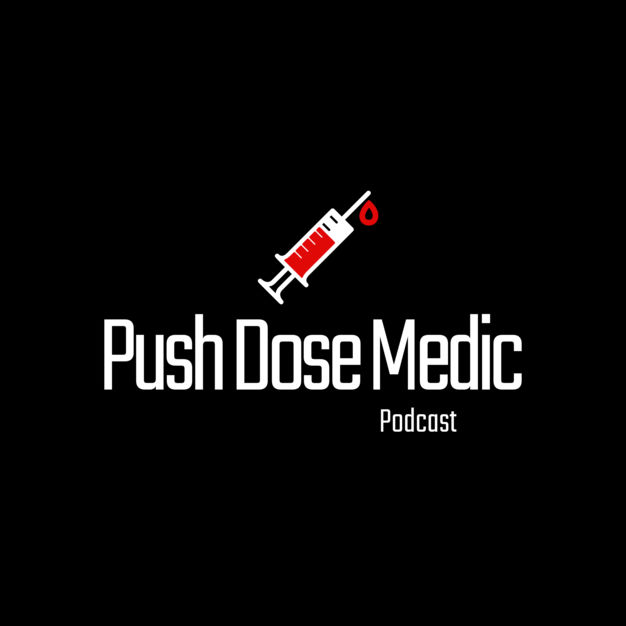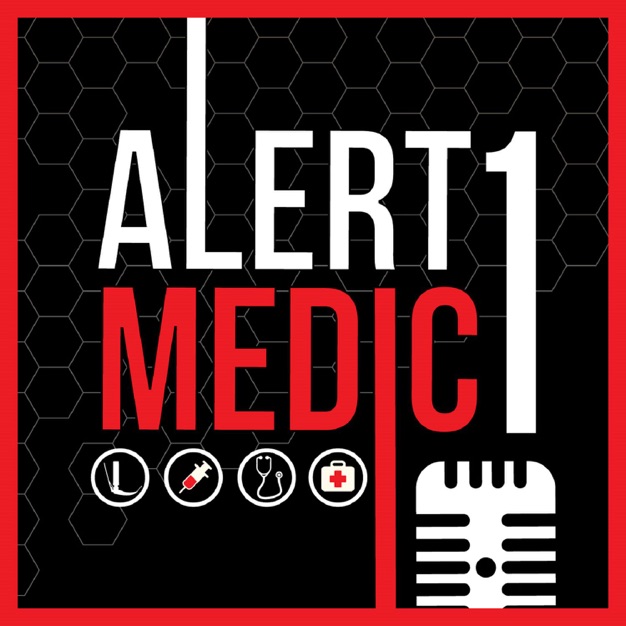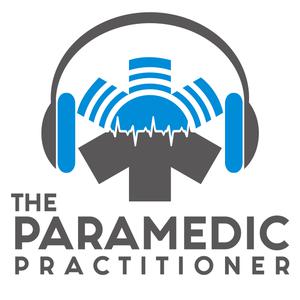
Push Dose Medic Podcast
Jaren Jarrell
Providing education to bridge the gap from classroom to clinical setting for the beginner paramedic.
- 16 minutes 16 secondsAortic Dissection- The thunderclap of the chest
Dissections occur when the tunica intima and tunica media layers of the aorta weaken and tear causing blood to create a false lumen. Different classifications determine severity and treatments.
——Standford Classification——
Type A- Ascending aorta and can continue to the arch and/or the descending aorta.
Type B- Involves the descending aorta distal of the left subclavian artery.
——Risk factors/Presentation——
HTN, tissue disorders, Marfans syndrome, age, and male gender. These patients will present with classic ripping/tearing chest pain that radiates to back, sometimes to abdomen depending on location of dissection. Focal neuro defects, BP/pulse deficits, N/V, SHOB, diaphoreses etc.
——Diagnosis——
Initial diagnosis starts with a good history of the patient to see if the qualify with high risk factors, next is imaging. CXR does not rule out a dissection but clue you in with a widened mediastinum. Next is the gold standard which is CT, some complications may arise with decreased renal function and contrast. If patient is stable enough MRI is possible. Other options are TEE (requires ETI), or TTE. These both have restrictions in imaging the full aorta for diagnosis.
——Treatments——
Treatments depends on type of dissection.
——Type A——
Require immediate emergent cardiac surgery. Due to the nature and location of the dissection patient is at risk for hemorrhage, hypo perfusion to vitals organs. Usually repaired with aortic graft/replacement.
——Type B——
Unless complicated with hypo perfusion which would require surgical consult (TEVAR) with stent placement, type B is management with medication. Anti-impulse therapy is initiated long term with medications to control HR and BP.SUBSCRIBE AND LEAVE A RATING ON ITUNES!!!
If you have any questions please feel free to contact me at [email protected]
The Push Dose Medic website is live!!! www.pushdosemedic.com
14 May 2021, 10:00 am - 13 minutes 47 secondsWolff-Parkinson-White
Remember the WPW Triad
1. Short PR Interval 120ms
3. Delta Wave
*This is WPW pattern, patients that present symptomatic then have WPW syndrome.*
WPW EKG- Notice the slight upstroke into the QRS complex, that's the delta wave!
Treatments-
Most people will be asymptomatic with just WPW pattern, monitor for any tachycardia and hypo perfusion.
Symptomatic patients receive synchronized cardioversion, remember UNSTABLE GETS THE CABLE!
WPW does not receive ABCD!
- Adenosine
- Beta-Blockers
- Calcium Channel Blockers
- Digoxin
SUBSCRIBE AND LEAVE A RATING ON ITUNES!!!
If you have any questions please feel free to contact me at [email protected]
9 May 2021, 10:00 am - 40 minutesTalking LVADs with Dillon Wenberg
Ventricular assist devices can be confusing and scary to manage. Having knowledge can increase your confidence and the care delivered to your patient. I talked with Dillon Wenberg, IA MED critical care instructor and co-author of the NEW IA MED MCAD course/book. We discussed all of the commonly asked questions about LVADs in prehospital settings.
28 December 2020, 11:00 am - 19 minutes 32 secondsThe Prehospital PE
Join us today as we discuss pulmonary embolisms. This is a common diagnosis you will need to identify and treat within the prehospital setting. Check out some resources below. Enjoy, and don't forget to subscribe on iTunes and leave a rating.
SUBSCRIBE AND LEAVE A RATING ON ITUNES!!!
If you have any questions please feel free to contact me at [email protected]
The Push Dose Medic website is live!!! www.pushdosemedic.com
Merchandise is available through the store. Remember that 75% of proceeds go directly to Uniformed Services Peer Council at https://uniformedhelp.org
V/Q MISMATCH
Eight Pearls for the crashing PE
Actual EKG from my patient. 26 y/o male, syncopal episode, SHOB, CP. DX- Saddle PE.
***Note the S1Q3T3***
Source by PushDoseMedic Podcast
25 July 2020, 8:00 pm - 21 minutes 33 secondsWhat is hyperkalemia??
Join in today's episode with a overview of hyperkalemia. Like most topics in paramedic school, this is one that "you don't really need to know". Well turns out its pretty darn important. Check out some resources below and infographics on topics discussed.
Check out LITFL for some awesome hyperkalemia EKG examples
https://litfl.com/hyperkalaemia-ecg-library/
Check out IAMED on facebook on Thursdays at 1900 CST for some great updates on COVID-19 and awesome weekly topics with the industries best clinicians.
Mental wellness is important in this busy time! Check out the Motivated Medic and 911 Buddy Check for some great resources on mental wellness and inspiration.
SUBSCRIBE AND LEAVE A RATING ON ITUNES!!!
If you have any questions please feel free to contact me at [email protected]
TWITTER- @pushdosemedic
The Push Dose Medic website is live!!! www.pushdosemedic.com
Merchandise is available through the store. Remember that 75% of proceeds go directly to Uniformed Services Peer Council at https://uniformedhelp.org
27 April 2020, 3:12 pm - 10 minutes 20 secondsDKA vs HHNS Part 2
In this series we looked at DKA and HHNS, two common hyperglycemic calls a paramedic may encounter in the prehospital setting.
Part 2 discusses HHNS. How is this different than DKA, and how do we treat it. Tune in and find out.
THANK YOU TO ALL OF OUR PARAMEDICS, EMTS, NURSES, PHYSICIANS, RESPIRATORY THERAPISTS AND MORE. EVERYONE IN HEALTHCARE RIGHT NOW IS FACING A PANDEMIC WITH COVID19. STAY STRONG WE CAN DO IT. WE WILL ALL LEARN FROM THIS. STAY SAFE!
SUBSCRIBE AND LEAVE A RATING ON ITUNES!!!
If you have any questions please feel free to contact me at [email protected]
The Push Dose Medic website is live!!! www.pushdosemedic.com
Merchandise is now available through the store. Remember that 50% of proceeds go directly to The Code Green Campaign.
22 March 2020, 1:00 pm - 17 minutes 50 secondsDKA vs HHNS Part 1
Hyperglycemia is a common call a provider will encounter, wether in the prehospital setting or the emergency room.
As a prehospital provider our interventions are limited, but it is still important to understand the pathophysiology of this disease.
In this two part series lets break down two manifestations of hyperglycemia, DKA and HHNS.
FlightBridgeEd Episode- Know your labs, diagnosing DKA using beta-hydroxybutyrate
SUBSCRIBE AND LEAVE A RATING ON ITUNES!!!
If you have any questions please feel free to contact me at [email protected]
The Push Dose Medic website is live!!! www.pushdosemedic.com
Merchandise is now available through the store. Remember that 50% of proceeds go directly to The Code Green Campaign.
11 March 2020, 12:40 am - 19 minutes 17 secondsA deeper look into antihypertensives
Join me today as we take a deeper look into antihypertensive medications. We go over some of the most common medications you may see including, beta blockers, CCB, ARB's, and more.
SUBSCRIBE AND LEAVE A RATING ON ITUNES!!!
Follow us on Twitter- @pushdosemedic
If you have any questions please feel free to contact me at [email protected]
The Push Dose Medic website is live!!! www.pushdosemedic.com
Merchandise is now available through the store. Remember that 50% of proceeds go directly to The Code Green Campaign.
4 March 2020, 7:40 pm - 11 minutes 22 secondsIntro to RAAS!
Let’s break down the RAAS system! It’s super simple and easy to understand!
So the renin-angiotensin-aldosterone-system is a complex pathway and regulatory system, that responds to decreased pressure and volume within the body. This system is important for blood pressure management but can be altered in chronic medical conditions. This system involves multiple organs and enzymes including the kidneys, liver, lungs, and heart.
I recommend taking a look below at this nephron to familiarize yourself with renal vocabulary.
SUBSCRIBE AND LEAVE A RATING ON ITUNES!!!
If you have any questions please feel free to contact me at [email protected]
The Push Dose Medic website is live!!! www.pushdosemedic.com
Merchandise is now available through the store. Remember that 50% of proceeds go directly to The Code Green Campaign.
12 December 2019, 2:24 pm - 45 minutes 57 secondsCapnography 101
Today we take a look at capnography! Capnography is a useful tool used mainly in the prehospital setting, that reveals a plethora of information. Now we all know that we use capnography on our respiratory patients, but how else can we use it? Ever heard of monitoring perfusion status while pacing?
Check out this weeks episode as I sit down with John Carrico. John Carrico is a flight paramedic who is passionate about anything and everything respirtory. We sit down today to talk all things capnography.
Check out Bob Page's website on capnography-"Slap the Cap"
Applications of End-Tidal Carbon Dioxide Monitoring
Small study on capnography reliability
SUBSCRIBE AND LEAVE A RATING ON ITUNES!!!
If you have any questions please feel free to contact me at [email protected]
The Push Dose Medic website is live!!! www.pushdosemedic.com
Merchandise is now available through the store. Remember that 50% of proceeds go directly to The Code Green Campain.
1 December 2019, 3:28 pm - 42 minutes 35 secondsPART 2 of Pediatric Care with Dr. Antevy
We all know pediatric calls can be stressful, complicated, and chaotic. There has always been a stigma that pediatric patients should be treated differently, this puts a mental block in our heads that affect us and the patient. I invite you to listen to Dr. Antevy, and myself as we discuss pediatric care guidelines and PEARLS. In this two-part series, we will discuss, multiple topics from pitfalls in EMS in regards to pediatrics, to creating closure with families.
Subscribe to iTunes!
http://bit.ly/HandtevyDemo - Handtevy App Demo
https://youtu.be/PnqUtpygojc - i-Gel Airway
https://www.handtevy.com/wp-content/uploads/2019/01/Banerjee-Pepe-Resuscitation-2019.pdf - Pediatric resuscitation paper
Follow Dr. Antevy on the following social media.
If you have any questions in regard to pediatric care, feel free to reach out!
Twitter: @HandtevyMD
Facebook: Handtevy
YouTube: Handtevy and Palm Beach County Fire Rescue
4 October 2019, 4:42 pm - More Episodes? Get the App
Your feedback is valuable to us. Should you encounter any bugs, glitches, lack of functionality or other problems, please email us on [email protected] or join Moon.FM Telegram Group where you can talk directly to the dev team who are happy to answer any queries.
 Motivated Medic Podcast
Motivated Medic Podcast
 After the Call
After the Call
 The EMS Lighthouse Project
The EMS Lighthouse Project
 Alert Medic 1 - Podcast
Alert Medic 1 - Podcast
 The Paramedic Practitioner
The Paramedic Practitioner